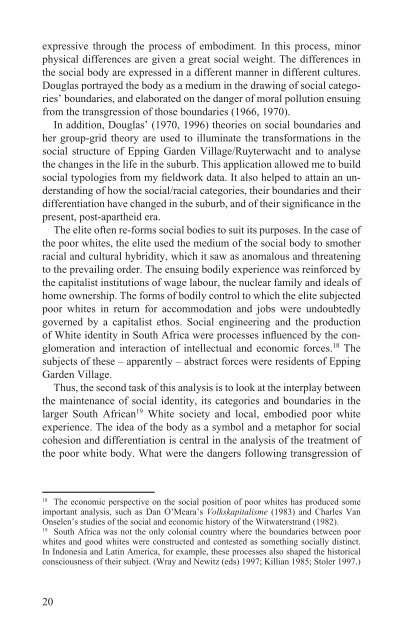The Making of a Good White - E-thesis - Helsinki.fi
The Making of a Good White - E-thesis - Helsinki.fi
The Making of a Good White - E-thesis - Helsinki.fi
You also want an ePaper? Increase the reach of your titles
YUMPU automatically turns print PDFs into web optimized ePapers that Google loves.
expressive through the process <strong>of</strong> embodiment. In this process, minor<br />
physical differences are given a great social weight. <strong>The</strong> differences in<br />
the social body are expressed in a different manner in different cultures.<br />
Douglas portrayed the body as a medium in the drawing <strong>of</strong> social categories’<br />
boundaries, and elaborated on the danger <strong>of</strong> moral pollution ensuing<br />
from the transgression <strong>of</strong> those boundaries (1966, 1970).<br />
In addition, Douglas’ (1970, 1996) theories on social boundaries and<br />
her group-grid theory are used to illuminate the transformations in the<br />
social structure <strong>of</strong> Epping Garden Village/Ruyterwacht and to analyse<br />
the changes in the life in the suburb. This application allowed me to build<br />
social typologies from my <strong>fi</strong>eldwork data. It also helped to attain an understanding<br />
<strong>of</strong> how the social/racial categories, their boundaries and their<br />
differentiation have changed in the suburb, and <strong>of</strong> their signi<strong>fi</strong>cance in the<br />
present, post-apartheid era.<br />
<strong>The</strong> elite <strong>of</strong>ten re-forms social bodies to suit its purposes. In the case <strong>of</strong><br />
the poor whites, the elite used the medium <strong>of</strong> the social body to smother<br />
racial and cultural hybridity, which it saw as anomalous and threatening<br />
to the prevailing order. <strong>The</strong> ensuing bodily experience was reinforced by<br />
the capitalist institutions <strong>of</strong> wage labour, the nuclear family and ideals <strong>of</strong><br />
home ownership. <strong>The</strong> forms <strong>of</strong> bodily control to which the elite subjected<br />
poor whites in return for accommodation and jobs were undoubtedly<br />
governed by a capitalist ethos. Social engineering and the production<br />
<strong>of</strong> <strong>White</strong> identity in South Africa were processes influenced by the conglomeration<br />
and interaction <strong>of</strong> intellectual and economic forces. 18 <strong>The</strong><br />
subjects <strong>of</strong> these – apparently – abstract forces were residents <strong>of</strong> Epping<br />
Garden Village.<br />
Thus, the second task <strong>of</strong> this analysis is to look at the interplay between<br />
the maintenance <strong>of</strong> social identity, its categories and boundaries in the<br />
larger South African 19 <strong>White</strong> society and local, embodied poor white<br />
experience. <strong>The</strong> idea <strong>of</strong> the body as a symbol and a metaphor for social<br />
cohesion and differentiation is central in the analysis <strong>of</strong> the treatment <strong>of</strong><br />
the poor white body. What were the dangers following transgression <strong>of</strong><br />
18<br />
<strong>The</strong> economic perspective on the social position <strong>of</strong> poor whites has produced some<br />
important analysis, such as Dan O’Meara’s Volkskapitalisme (1983) and Charles Van<br />
Onselen’s studies <strong>of</strong> the social and economic history <strong>of</strong> the Witwaterstrand (1982).<br />
19<br />
South Africa was not the only colonial country where the boundaries between poor<br />
whites and good whites were constructed and contested as something socially distinct.<br />
In Indonesia and Latin America, for example, these processes also shaped the historical<br />
consciousness <strong>of</strong> their subject. (Wray and Newitz (eds) 1997; Killian 1985; Stoler 1997.)<br />
20
















